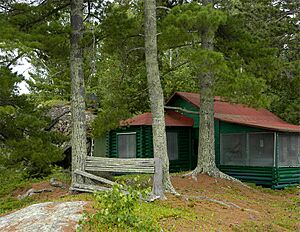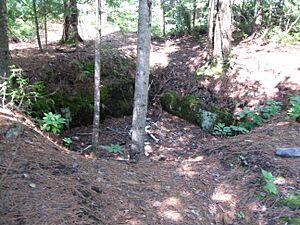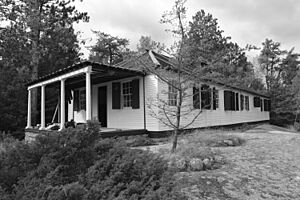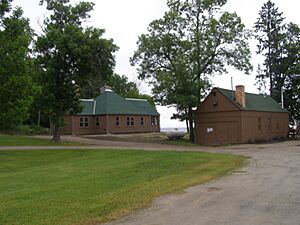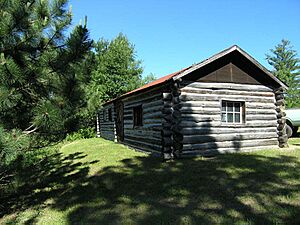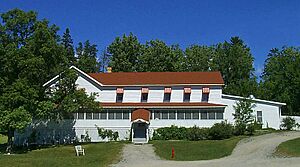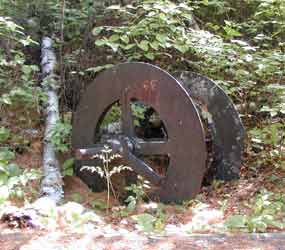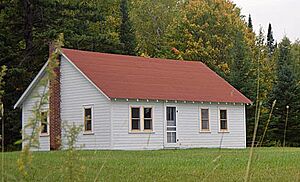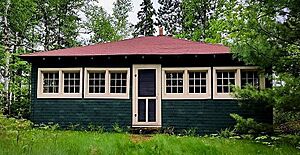National Register of Historic Places listings in Voyageurs National Park facts for kids
Voyageurs National Park in Minnesota is a beautiful place with many lakes and forests. But did you know it's also home to some really old and important sites? These places are so special that they are listed on the National Register of Historic Places. This is like a special list kept by the United States government to protect buildings, places, and objects that are important to history.
There are eleven properties and districts in Voyageurs National Park that are on this important list. They tell us stories about people who lived here long ago, how they lived, and what they did.
Ancient Campsites and Homes
Many of the historic sites in Voyageurs National Park are very old archaeological sites. These are places where scientists have found clues about ancient people.
King Williams Narrows Site
This site, also known as Archeological Site No. 21SL82, was a campsite used by people for a very long time. It was active from about 3000 BCE (that's over 5,000 years ago!) all the way up to 1900 CE. Imagine people camping in the same spot for thousands of years!
Sweetnose Island Site
Archeological Site 21SL141 on Sweetnose Island was a place where people lived. It was occupied from about 300 CE to 1900 CE. This means different groups of people called this island home over many centuries.
Clyde Creek Site
The Clyde Creek Site (Archeological Site 21SL35) is a large beach area. It was mainly used by a group called the Laurel Complex during the early Woodland period. What's really cool about this site is that it might have the earliest proof of people using wild rice in Minnesota. Wild rice was a very important food source for many Native American groups.
Island Home of the Blackduck Culture
Archeological Site 21SL55 is an island site. It was used only by the Blackduck culture during the late Woodland period. Scientists found signs of a possible "ricing jig" here. This was a tool used to process wild rice.
Seasonal Campsite 21SL73
Archeological Site No. 21SL73 was a campsite used at different times of the year. People visited this spot from about 100 BCE to 1500 CE. It was a place where they would set up camp for certain seasons, perhaps for hunting, fishing, or gathering.
Historic Buildings and Districts
Besides ancient sites, there are also more recent historic places that show how people lived and worked in the park area in the last few centuries.
Jun Fujita Cabin
On Wendt Island, you can find the rustic cabin of Jun Fujita. He was a Japanese American photographer and poet. He built this cabin in 1928. It's a special example of the early vacation homes built in the Boundary Waters area.
Gold Mine Sites
Around Rainy Lake, there are several gold rush sites. These are places where people dug for gold in 1894. This gold rush brought new industries and settlements to the area. The district includes seven old mine shafts and test pits.
William Ingersoll Estate
The William Ingersoll Estate was a summer home complex on Ingersoll's Island. It was built in the 1920s. The main cabin, built in 1928, was special because it was a rare prefabricated "kit house" from the E. F. Hodgson Company. Sadly, the main cabin collapsed in 2014 and was later removed.
Kabetogama Ranger Station District
On the southwestern shore of Kabetogama Lake is the Kabetogama Ranger Station District. This group of buildings was constructed between 1933 and 1941. It was built by the Civilian Conservation Corps, a program that helped people find work during the Great Depression. The buildings show a style called National Park Service rustic architecture.
Kettle Falls Historic District
The Kettle Falls Historic District is located at Kettle Channel. This area includes a dam, two log buildings, and a hotel. They were built around 1910–1914. Kettle Falls was an important stopping point on the Canada–United States border. It was a busy place for industry and tourism, even though it was far from other towns.
Kettle Falls Hotel
The Kettle Falls Hotel was built in 1913. It provided a place to stay and eat for many different people. Commercial fishermen, lumberjacks, buyers, and tourists all stayed here. It was a key spot in a roadless area, deep in the wilderness.
Adolph Levin Cottage
The Adolph Levin Cottage is near the Ash River Maintenance Dock. This log cabin, built in 1937, is a great example of an early 20th-century lake retreat. It's known for its rustic architecture and traditional Finnish building style.
Little American Mine
On Little American Island, you can find the remains of the Little American Mine. This was Minnesota's only gold mine that actually made a profit! It operated from 1893 to 1898. Today, there's a special trail where you can learn about its history.
Monson's Hoist Bay Resort
Monson's Hoist Bay Resort was started in 1939 on Namakan Lake. It was built to welcome more and more middle-class tourists. The resort has nine buildings constructed between 1941 and 1968. It shows how family-owned resorts grew popular.
I.W. Stevens Lakeside Cottage
The I.W. Stevens Lakeside Cottage is on Williams Island, also on Namakan Lake. This lake cabin complex was built in 1932. It's still mostly as it was back then, with seven buildings. It was used as a home all year round and also as a small resort.
Images for kids


